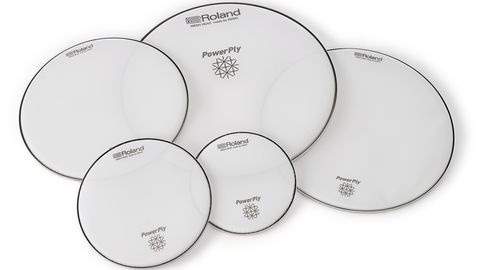Up until recently Roland's mesh heads were only available as a 'spare part' and from Roland directly.
Now the range has increased to allow acoustic drummers to 'go mesh', transforming their kits into electro/ acoustic hybrids by dropping into their local music store. V-Drum owners, too, can now purchase replacement heads for their e-kits.
There are nine models available, in the most popular drum sizes - 8" to 22". These are the same type as found on V-Drum kits, where the new examples are also dual-ply and made by Remo.
Not to be confused with Remo's own SilentStrokes, as these are single-ply. Roland says its dual-ply mesh heads produce the most accurate results when used with the RT-30 triggers.
While the heads are resilient and extremely hard-wearing, it is best not to use metal brushes or felt beaters with them. Roland recommends you use wood or plastic beaters, and we would advise using plastic brushes.
Hands On
For the purposes of the review, Roland has kindly loaned us a pair of RT-30 triggers, a TM-2 trigger/sound module and a selection of the new heads.
We are swapping some of the batters on the kit including three toms, snare and kick. As with any acoustic head, it is important to apply tension evenly - tightening up quarter of a key turn until it becomes hard to make a thumb impression at the edge.
Unlike with standard acoustic heads we are not tensioning for pitch but for how they feel under the sticks. This has an advantage over acoustic heads, especially on the lower pitched drums such as the lower toms and kick drum - we don't have to retain any slack in order to achieve a low pitch - we'll let the TM-2 deal with that!
With the triggers clamped in position we can begin to introduce some electronic sounds. At first, the rebound can be a little unnerving for those in unfamiliar mesh territory - the heads act as a real springboard.
This is especially noticeable on the larger toms as we would normally have these fairly slack to give them a little more oomph. As a predominantly acoustic player, it's a case of remembering, when turning that key, it won't affect pitch, just tension.
This level of taut tension may also be applied to the bass drum and here the beaters become turbo charged. However, this has the effect of losing the apparent physical low-end - here Roland's Jules Tabberer- Stewart helps out.
He suggests placing a felt strip behind the head - a bit like a dampening strip. With this in place it works a treat, giving the real impression of more bottom end and ultimately giving a punchier feel.
Without any adjustment necessary to the RT-30s the response is instant and accurate. Picking up the tiniest ghosted strikes, hard whacks and everything in between. Headphones off, there is still a slight ring from the resonant heads which acts as an unexpected monitor.
As the ultimate sound doesn't depend on the material the kit is made of, the heads could easily convert any acoustic kit.

